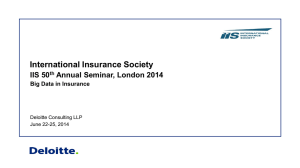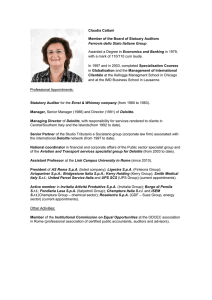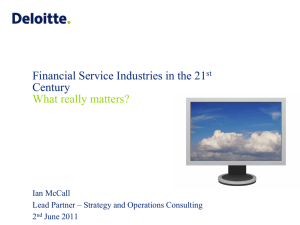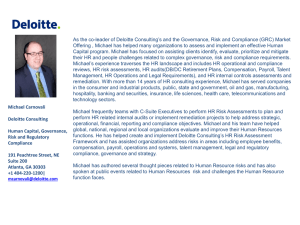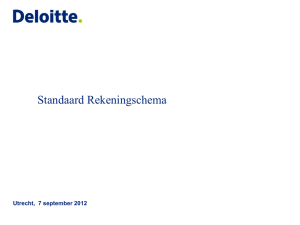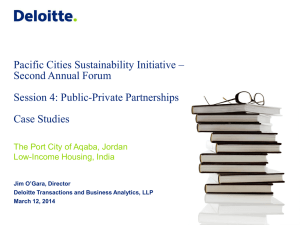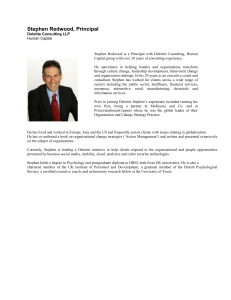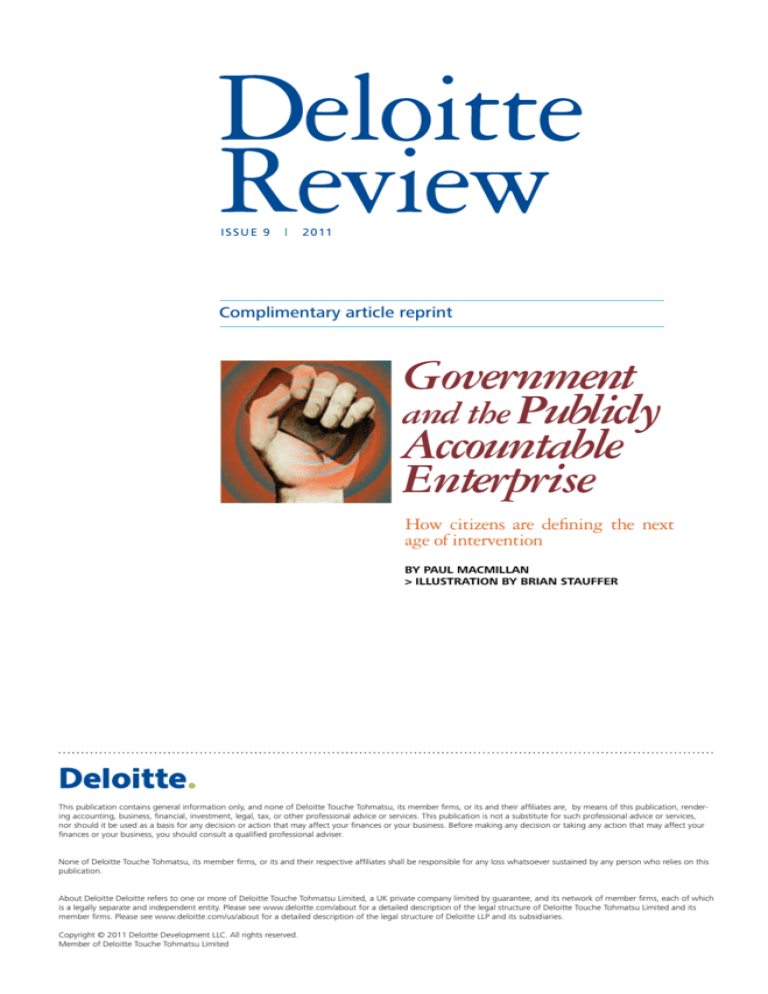
i s s u e 9 |
2 011
Complimentary article reprint
Government
and the Publicly
Accountable
Enterprise
How citizens are defining the next
age of intervention
By paul macmillan
> Illustration by brian stauffer
This publication contains general information only, and none of Deloitte Touche Tohmatsu, its member firms, or its and their affiliates are, by means of this publication, rendering accounting, business, financial, investment, legal, tax, or other professional advice or services. This publication is not a substitute for such professional advice or services,
nor should it be used as a basis for any decision or action that may affect your finances or your business. Before making any decision or taking any action that may affect your
finances or your business, you should consult a qualified professional adviser.
None of Deloitte Touche Tohmatsu, its member firms, or its and their respective affiliates shall be responsible for any loss whatsoever sustained by any person who relies on this
publication.
About Deloitte Deloitte refers to one or more of Deloitte Touche Tohmatsu Limited, a UK private company limited by guarantee, and its network of member firms, each of which
is a legally separate and independent entity. Please see www.deloitte.com/about for a detailed description of the legal structure of Deloitte Touche Tohmatsu Limited and its
member firms. Please see www.deloitte.com/us/about for a detailed description of the legal structure of Deloitte LLP and its subsidiaries.
Copyright © 2011 Deloitte Development LLC. All rights reserved.
Member of Deloitte Touche Tohmatsu Limited
78
A ov
g
R T IeCrLn
Em
T IeTnLtE a n d t h e p u b l i c ly ac c o u n ta b l e e n t e r p r i s e
Deloitte Review
d e l o i t t e r e v i e w. c o m
g ov e r n m e n t a n d t h e p u b l i c ly ac c o u n ta b l e e n t e r p r i s e
Government
and the Publicly
Accountable
Enterprise
How citizens are defining the next age of intervention
By paul macmillan > Illustration by brian stauffer
T
he global financial crisis that began in 2007 has brought
significant government intervention in developed countries
worldwide. Financial system reforms, stimulus spending and
direct capital infusions were just some of the initiatives deployed to stave off an even deeper recession. While these efforts have enjoyed some success, in many parts of the world the economic slowdown is
far from over. Governments remain watchful over their economies. Seeking to avoid another meltdown, they are working to rebalance the state of
deregulation begun in the Thatcher-Reagan years.
While the level of economic stimulus and regulatory intervention
was unprecedented, it has accompanied a more fundamental shift in the
public landscape – one that may have further reaching and longer lasting
implications for how businesses are governed and managed. An explosion of mobile communications and social media is empowering citizens
to take hold of the public agenda. Mobile devices and social media are
effectively ubiquitous – 35 hours of video are being loaded onto YouTube every minute. In addition, social media have arrived as a legitimate
source for news: According to a recent survey of more than 1,000 business
journalists from over 35 countries, 90 percent source news from social
media, far outstripping reliance on direct information from companies
(21 percent) and analysts’ research (13 percent).1 While leading corporations understand the value of marketing through social media, the phenomenon comes with a price: The light of transparency has never been
brighter nor has the tolerance for misinformation ever been lower.
d e l o i t t e r e v i e w. c o m
Deloitte Review
79
80
g ov e r n m e n t a n d t h e p u b l i c ly ac c o u n ta b l e e n t e r p r i s e
With connectedness comes empowerment. WikiLeaks has received millions of
documents from citizens eager to expose government and corporate secrets. As
events in North Africa and the Middle East have shown, the political terrain can
change rapidly when aided by the flow of news and information. But it is not just
autocratic dictators that are impacted. Properly elected governments, global CEOs
and iconic brands also face a new reality: Citizens are defining the next age of intervention and setting new standards for public accountability.
At the same time, citizen confidence in government and business has been
shaken. Insider trading, Ponzi schemes, mortgage meltdowns, collapsing banks,
product recalls and oil spills have convinced people that more active monitoring is
needed. In response, legislation like Sarbanes-Oxley, and more recently the DoddFrank Wall Street Reform and Consumer Protection Act, have institutionalized
corporate whistle-blowing. And while business and finance become more globally
interconnected, the limits of national autonomy become more evident. The citizens of Iceland, Ireland, Greece and Portugal have come to appreciate how the demands and limitations of global financial markets can impact national economies.
Citizens are creating an atmosphere of transparency and accountability that
goes well beyond traditional notions of corporate social responsibility. Boards of
directors and executive management are under pressure to exercise broader accountability to the public. In matters of ethics and integrity, the line between
shareholder and citizen expectations has all but disappeared. What justification,
for example, would shareholders or citizens accept for doing business with corrupt
dictators or with suppliers employing child labor? These issues now play out on a
very public stage, with rapid consequences for marquee brands.
The evolution of intervention
L
ike many relationships, government, business and the economy have a long
and sometimes stormy history. The creation of central banks to manage mon-
etary policy; the establishment of crown agencies to provide critical infrastructure;
the formation of the IMF, World Bank and European Union; and the introduction
of regulated stock exchanges all indicate government’s evolving role. In fact, there
have been a number of distinct ages of intervention since the Great Depression.
The fault lines for the new age of public accountability can be traced to the
beginning of the 21st century. The terrorist attacks of September 11, 2001 re-
sulted in increased powers for governments to access personal information held by
corporations. A series of well-publicized accounting scandals opened the door to
governments strengthening corporate oversight. Defaulting financial institutions
set governments on a path to define “too big to fail.” Yet, perceived lax oversight of
Deloitte Review
d e l o i t t e r e v i e w. c o m
iconic events
Age
g ov e r n m e n t a n d t h e p u b l i c ly ac c o u n ta b l e e n t e r p r i s e
National economy building
1920s-1930s
International
cooperation
1940s-1950s
Oil crisis
1960s-1970s
The
retrenchment
1980s-1990s
Public
accountability
2000 and beyond
•1929 stock
market crash
•Second World
War and recovery
•Oil crisis
•New public
management
and deregulation
•Dot-com crash
•Depression and
post-Depression
•Oil glut
•Black Monday
(1987)
•Early 90s recession
•U.S. bank failures, Glass–Steagall Act of 1933,
establishment of
the Federal Deposit Insurance
Corporation
•U.S. and retaliatory tariffs
impact international trade
•Formation of
public utilities
and institutions:
Government actions
- Canadian Wheat
Board
- Canadian Broadcasting Corporation (CBC)
- Bank of Canada
- Ontario Securities Commission
•High government spending
on large scale
rearmament
•High oil
prices cripple
western
economies
•Reduced
unemployment; doubled
economic growth
rates
•U.S. wage
and price
controls
•Establishment
of General
Agreement on
Tariffs and Trade
(predecessor to
WTO)
•Formation of:
- The International
Monetary Fund
•U.S. deregulation of
airlines and
trucking
•Formation of:
- OPEC and G7
- Canada
Development
Corporation - The World Bank
- The European
Union
•2000-’02 market
crash
•Enron
•9/11
•2007 financial
crisis
•Sharply increased interest
rates from
1979-1983 to
the highest rate
in history
•Low interest rates
•Increased market orientation
by government
(New Public
Management)
- Income Trust
Regulations
•Privatizations:
Air Canada and
Petro-Canada
- Dodd–Frank Wall
Street Reform
and Consumer
Protection Act
•Bank deregulation in the U.S.
•Revisions to
Canadian Bank
Act, permit bank
subsidiaries in
various financial
services
•Establishment of:
- Sarbanes–Oxley
Act
- Patriot Act
- Global Stimulus
Policy
- Financial Stability
Oversight Council
- Strengthening of
financial stability
and depositor protection (U.K.)
•Establishment of National Energy Program
•North American Free Trade
Agreement
•Newspapers dominate news
•Early introduction of
television
media & culture
•Stagflation
•Moon •Beginning of
landing
capitalism versus communism
•Vietnam war
•Rock ‘n’ roll
•Blockbuster
movies take
•Television overhold
takes radio and
newspapers in
media dominance
•Introduction and
gradual mass
use of personal computers
•Birth of the Web
•Growth of
24-hour news
(CNN)
•Embedded
journalists (First
Gulf war)
•Y2K
•Canadian Internet
use: 42% in 2000
to 75.3% in 2008
•0.5-1.35 billion
mobile phone
subscriptions in
OECD countries
(2000-2007)
•Facebook 100-400 million
users (2008-2010)
•Twitter (4 billion
tweets in the first
quarter of 2010)
d e l o i t t e r e v i e w. c o m
Deloitte Review
81
82
g ov e r n m e n t a n d t h e p u b l i c ly ac c o u n ta b l e e n t e r p r i s e
offshore drilling, widely criticized responses to natural catastrophes like Hurricane
Katrina and the earthquake in Haiti, and a host of other challenges have cast governments, too, in an unfavorable light. Who is accountable when an offshore rig
explodes? Or when financial products become so complex that neither traders nor
regulators can understand them? In the past, a few investigative reporters would
doggedly work to uncover the truth. Today, anyone with Internet access and a mobile phone has the potential to become a field reporter or government watchdog.
The mainstreaming of social media
S
ocial media have taken government and business scrutiny to a new level, with
citizens mobilizing in ways previously unimagined by traditional government
and business institutions. Sites like Facebook and Twitter have become a cultural
phenomenon and let people organize and share information at a pace and scale
never before seen. More significantly, they are a powerful tool for social change,
giving the public the ability to build or destroy company reputations and influence government actions. On a single day, Saudi stock markets dropped 7 percent
on fears that numerous “Facebook groups” were mobilizing protests across the
region.2 Social media’s global reach and pervasiveness subject governments and
businesses to unprecedented transparency and public accountability by spreading
information faster to more people than was ever imaginable before.
So ci al m e d i a o n a r o l l
•A 2010 study of CNN’s international audience showed 43 percent of all online news
sharing takes place through social media networks and tools.3
•Twitter membership grew by 1,882 percent from Feb 2008 to 20094 and in June 2010
reached 190 million visitors per month, generating 65 million Tweets a day.5
Deloitte Review
d e l o i t t e r e v i e w. c o m
g ov e r n m e n t a n d t h e p u b l i c ly ac c o u n ta b l e e n t e r p r i s e
These forces create a context
for citizen intervention unlike
anything we have seen. When
In previous intervention
WikiLeaks reported it was hold-
ages, businesses needed to
ing potentially damaging infor-
be concerned about their
mation on some of the largest
direct operations and maybe
banks, stock markets took note.
their impacts on direct sup-
6
Given the media attention when
information was released on diplomatic messages, it was not hard
to imagine the reputational damage that the banks might suffer
if such corporate records were
released. Neither governments
pliers and customers. Today,
the second, third and even
fourth order consequences
of their decisions are important, and these impacts can
occur all over the globe.
nor businesses can operate as they
have in the past. Both are subject to global forces that are blurring the lines between private enterprise and public accountability.
The new age of intervention demands unparalleled public accountability.
When the U.S. federal government introduced its massive $787 billion stimulus
package with the 2009 American Recovery and Reinvestment Act, it recognized
this and immediately set up Recovery.gov, a Web site dedicated to reporting on
stimulus spending. The goal of the site was unparalleled transparency regarding
where money was being spent and what was being achieved. In addition to project
status information, including funding recipients, the site lets citizens report waste,
fraud and abuse, mobilizing millions of potential citizen watchdogs.
Conventional business risks can be magnified by the potential for public intervention – whether by governments or citizens. Public risks can emerge without
warning and rapidly go viral. Understanding and adapting to these risks requires
an ability to see beyond the bottom line and to understand how citizens and governments may view corporate actions.
In previous intervention ages, businesses needed to be concerned about their
direct operations and maybe their impacts on direct suppliers and customers. Today, the second, third and even fourth order consequences of their decisions are important, and these impacts can occur all over the globe. When poor labor practices
of Foxconn Technology, Apple’s China-based supplier of components for iPhones,
came to light and then went viral, Apple recognized the scope of the problem and
acted quickly. Reports that the suicide rates among the one million people working for Foxconn in China were similar to the national average added to the urgency
of the situation. A third-party report into labor practices across its China supplier
d e l o i t t e r e v i e w. c o m
Deloitte Review
83
84
g ov e r n m e n t a n d t h e p u b l i c ly ac c o u n ta b l e e n t e r p r i s e
network allowed Apple to identify and acknowledge a number of problems, while
outlining the corrective actions being taken.7 The working conditions in Chinese
plants would not have gone viral without cell phones and the Internet. Citizens on
the ground are likely more vigilant watchdogs than any government inspectors –
and they don’t necessarily heed diplomacy or borders in utilizing the new tools of
public accountability.
What the future holds
W
hile the nature of government intervention tends to change with elections
and watershed events, the implications of the age of public accountability
are still evolving. But a number of trends seem highly probable, at least in the
medium term.
First, governments will likely embrace a stronger regulatory role. This trend
will probably be driven by stressed governmental budgets and a perception that
businesses need to be held accountable.
The momentum of deregulation appears to have slowed, and governments seem
poised to probably take a stronger role in everything from financial systems to environmental protection. With the ability of markets to self-correct or self-regulate
in considerable question, governments will likely play an active role in managing global, national and—as seen in the case of energy production – even sitespecific risks. Increasingly, instead of prescribing specific courses of action,
governments are providing businesses with a set of expectations. This broader,
outcome-based regulatory approach places increased responsibility on businesses to
do the right thing in relation to both the intended and unintended consequences of
their actions.
From a government agency perspective, austere times suggest that government agencies with the strongest economic, security, environmental protection
and health-related mandates are likely to compete successfully for scarce government resources. Once funded, the agencies will likely face demands for increased
transparency and a climate of public accountability, making it imperative that they
show results by clearly enforcing compliance.
Second, greater public disclosure of corporate information will probably ensue. As privacy becomes a scarce commodity among citizens, there will likely be
decreasing acceptance of walls thrown around corporate activities. Whether this
scrutiny is “deserved” or “excessive” is a matter of politics and perspective, but the
underlying reality is that more corporate information will likely become available
to more people. In this scenario, the decision may not be one of how to lock down
information so much as to how and when to present it, and in what venues. The
Deloitte Review
d e l o i t t e r e v i e w. c o m
g ov e r n m e n t a n d t h e p u b l i c ly ac c o u n ta b l e e n t e r p r i s e
recent decision by the U.S. Federal Reserve Board to release over 25,000 pages of
documents showing which banks had used its discount window between 2007 and
2010 is an example of vaults of corporate information held by government agencies
being unlocked.
Last, near-term agendas are expected to take precedence over big policy ideas.
In the context of regulatory legislation, the methodical machinery of government
has historically resulted in legislative and regulatory change only after extensive
study. Governments, however, have become increasingly unlikely to spend years
analyzing major policy changes. Cycle times have gone from years to months.
Nor do governments tend to rely on existing regulatory models to address new
challenges. Citizens, special interest groups and politicians are coming to expect—
and influence—more responsive policymaking. The good news is that feedback on
government and business decisions is almost immediate. But it is challenging for
a leader to persevere with a long-term plan when faced with short-term resistance.
While this has led to more responsive government, it may well come at the expense
of longer-term public policy solutions.
Navigating the new public landscape
L
ike most business transformations, a key to success will be cultural change, in
this case with a particular focus on building a culture of public accountability.
This involves encouraging staff to understand the publicly transparent environment in which business is conducted today and the speed at which reputations
can be ruined and value eroded by poor decisions. Businesses need to be even more
vigilant about what behaviors they want to be associated with, with responsibility
for this vigilance recognized and shared throughout the organization.
There are specific actions that can improve a company’s chances of successfully
navigating the new public landscape.
Expand your understanding of public risk. Businesses need to expand
their risk management responsibilities beyond regulatory compliance. Regulators, shareholders and citizens expect managers to promote public accountability
throughout the enterprise and across the value chain. When Goldman Sachs was
faced with political and public criticism in the aftermath of the subprime mortgage crisis, it established a Business Standards Committee to advise the board of
directors with regard to the firm’s products and services and how they were viewed
by citizens. At an investor meeting, Chairman and CEO Lloyd Blankfein said that
there had been a disconnect between how the company viewed itself and how citizens perceived it.8
Look at the larger public picture. Boards and management must be mindful
d e l o i t t e r e v i e w. c o m
Deloitte Review
85
86
g ov e r n m e n t a n d t h e p u b l i c ly ac c o u n ta b l e e n t e r p r i s e
that repercussions of business actions can go beyond traditional business boundaries. By taking responsibility for a potential food contamination emergency and
responding immediately, for example, a company may help maintain confidence in
the broader public health system while identifying where corporate improvements
might be needed. A company’s decision to own the problem may prevent potentially counterproductive government action in a heated political climate.
Test compliance systems. Intense public scrutiny and a related demand for
transparency are both on the rise. Consider worst-case scenario planning to stresstest not just corporate performance, but where broader public interests could be
at risk. Contingency and disaster recovery plans should be updated to reflect the
challenges of operating under increased public accountability. Obviously you don’t
want to do this by creating a crisis, but it can be simulated to create an instructive
exercise.
It is important to stretch the boundaries in envisioning what a crisis might
become in order to prepare. War gaming, for example, is a methodology that attempts to find and mitigate the weakest links in an organization. It is an organizationwide, pre-emptive, focused approach to test and validate how an organization
will react to intense regulatory or public scrutiny. If a YouTube video is posted
of an employee asleep on the job, how would you react? If four or five videos are
posted on the same day of employees in different cities, what would you do? While
a sleeping employee is (usually!) not a crisis, to an online media-addicted culture it
can be an easily digestible mini-scandal.
Simulations can test the response plans of multiple agents within an organization as they react to pressure from regulators, consumers, politicians, investors and
the media – all while complying with statutory obligations. Such testing can also
uncover the strengths of the underlying and sometimes unstated assumptions and
principles behind business strategies, revealing organizational biases that could
undermine responsiveness to external pressures.
Collaborate with policymakers. Governments are under intense public scrutiny to address increasingly complex challenges – assessing and managing system
risks on a global scale and identifying and managing enterprises that are “too big
to fail,” for example. The scope and complexity of these and other risks will probably force business and government to collaborate intensively to meet public expectations and avoid catastrophic failures.
Governments make better decisions when they have a clear understanding of
specific industries, issues and concerns. By moving from compliance to collaboration, directors can facilitate a dialogue between government and business that
clarifies public issues for both. This is distinct from lobbying, which is often about
advocating or influencing the specifics of a specific law or agency decision.
Deloitte Review
d e l o i t t e r e v i e w. c o m
g ov e r n m e n t a n d t h e p u b l i c ly ac c o u n ta b l e e n t e r p r i s e
One way to enable this is for the board to include some members who have
worked on the government side and therefore have an appreciation of how government agencies think and act. Without this competency, boards can fail to understand the complexity of government decision-making and how companies can best
contribute to policy and regulatory processes.
Develop a culture of public accountability across the enterprise. Encourage executives and staff to think like citizens – rather than exclusively as shareholders or customers. Citizens are much more empowered today to hold businesses
publicly accountable. What was once regarded as an acceptable corporate response
to safety or other issues may not be today; and what’s accepted today may not be
tomorrow. Given the real risks of public outcry in the social media age, directors
would be well served to monitor the pulse of core societal concerns to protect both
the public interest and shareholder value.
At all levels of an organization, however, it is increasingly important for employees to understand and adapt to changing expectations on the part of governments and citizens. What are the potential implications of a particular course of
action? If later called upon to explain our decisions, are we comfortable presenting
our rationale to the public? Is there clarity within the organization as to how public accountability shapes our decisions? Among directors and management, there
may be significant benefits realized in an environment where the potential public
outcomes of business actions can be debated.
Citizens, as much or more than governments, are defining the new age of intervention. Empowered and connected, they are shaping a public agenda that holds
business and government accountable like never before. Embracing this new age of
public accountability is critical to navigating successfully in the future. DR
Paul Macmillan is a partner with Deloitte & Touche Canada and the Canadian Public Sector leader.
Endnotes
1.“Are analysts and investors engaging with new media?” http://www.brunswickgroup.com/insights-analysis/brunswickreview/brunswick-review-issue-2/research/engaging-with-new-media.aspx
2. Saudi Stocks slump nearly 7%
http://www.marketwatch.com/story/saudi-stocks-slump-egyptian-exchange-stays-closed-2011-03-01
3.“Social Networks dominate online news distribution.” Social Networking Watch. October 8, 2010. http://www.socialnetworkingwatch.com/2010/10/social-networks-dominate-online-news-distribution.html Web. November 18, 2010.
4. McGiboney, Michelle. “Twitter’s tweet smell of success.” Nielsen Online. March 18, 2009.
http://blog.nielsen.com/nielsenwire/online_mobile/twitters-tweet-smell-of-success/ Web. November 23, 2010.
5. Schonfeld, Erik. “Costolo: Twitter now has 190 million users tweeting 65 million times a day.” Techcrunch. June 8, 2010.
http://techcrunch.com/2010/06/08/twitter-190-million-users/ Web. November 23, 2010.
6. Bank’s stock declines on WikiLeaks anticipation.
http://online.wsj.com/article/SB10001424052748703994904575647180698155858.html
7. Apple Supplier Responsibility 2011 Progress Report. http://www.apple.com/supplierresponsibility/
8. Goldman Sachs to create “Internal Business Committee”. Huffington Post Business. May 2010.
http://www.huffingtonpost.com/2010/05/07/goldman-sachs-to-create-i_n_567681.html Web. April 7, 2011.
d e l o i t t e r e v i e w. c o m
Deloitte Review
87

